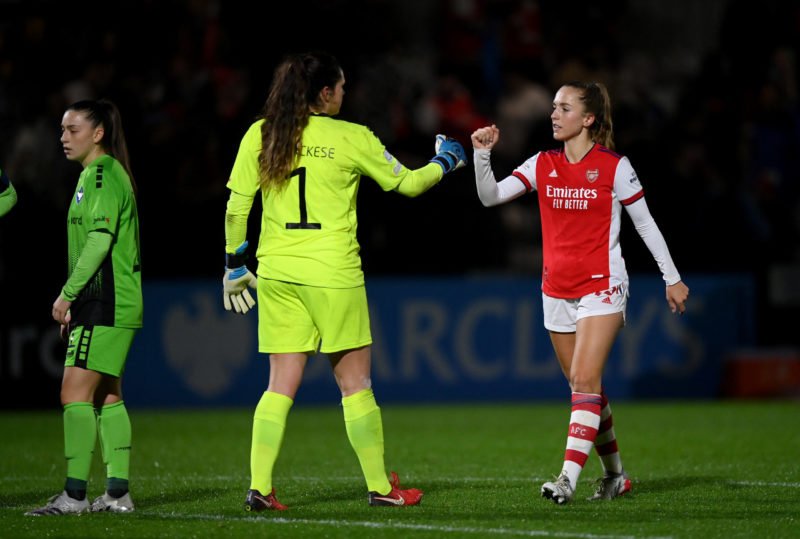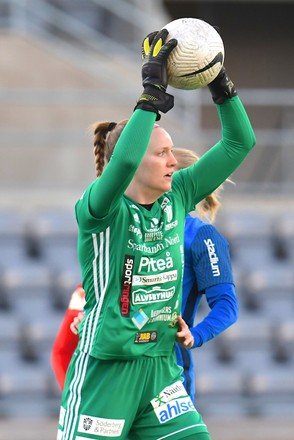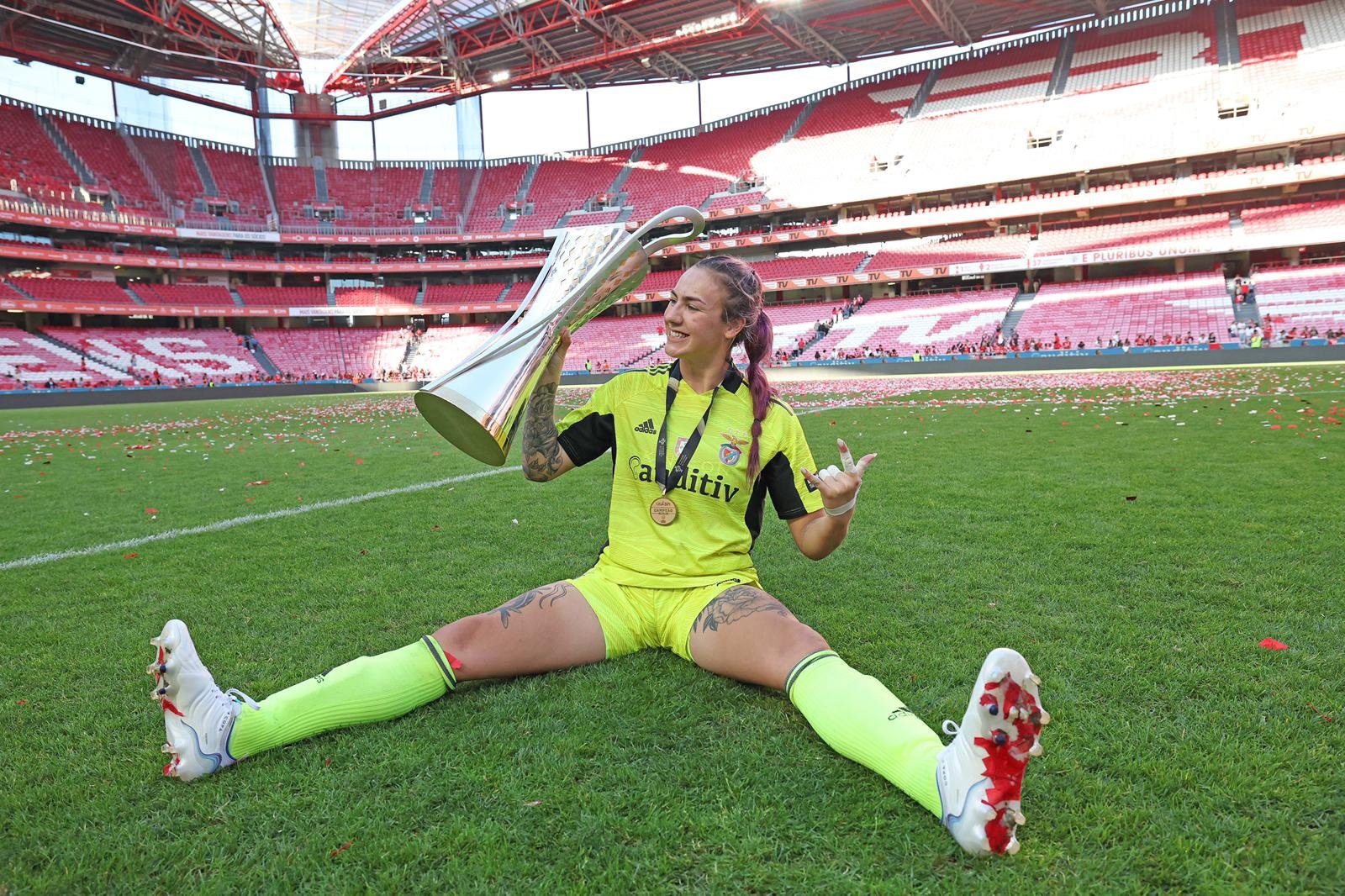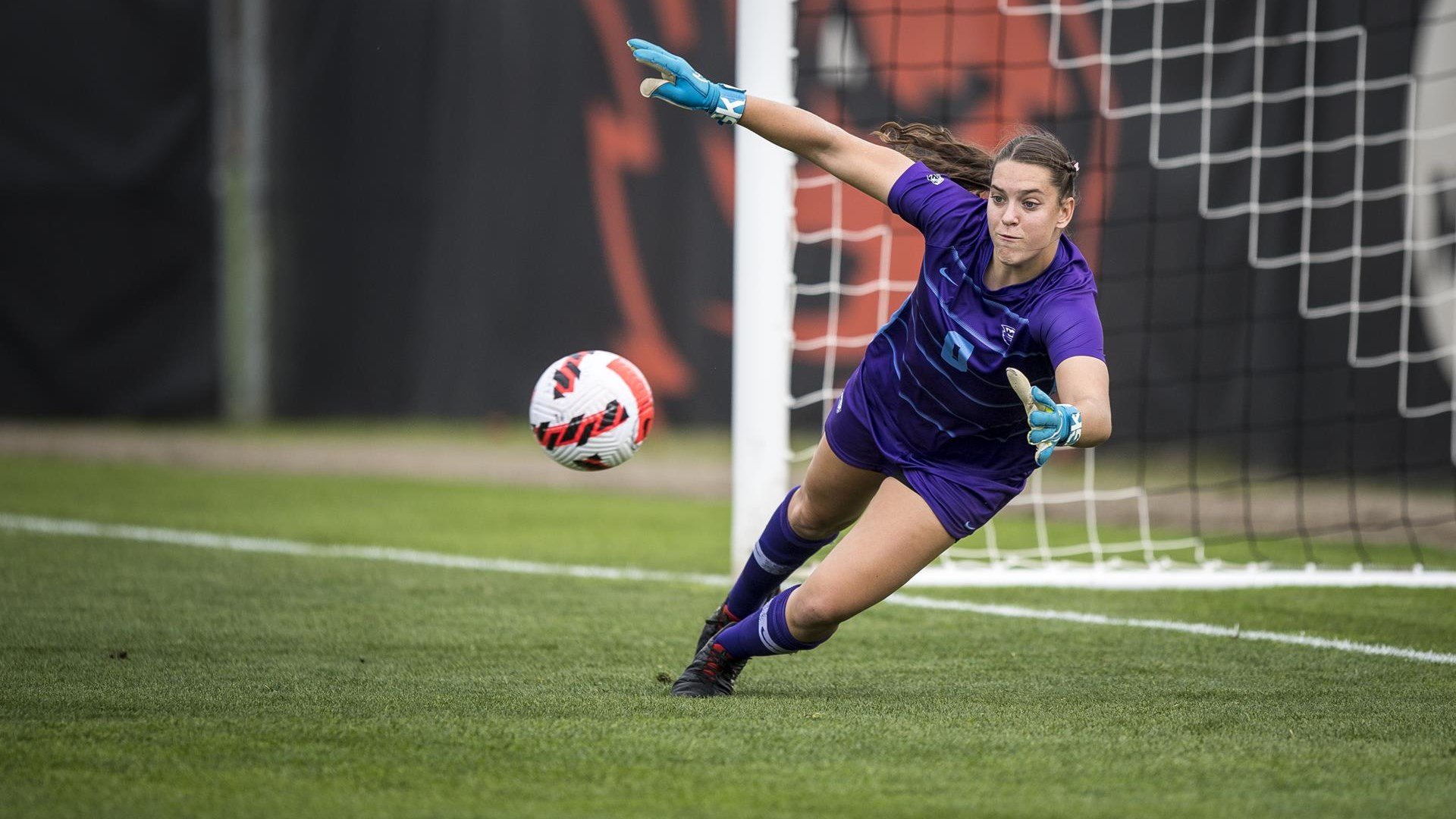This article is a guest-submitted article by a writer wishing to stay anonymous. The post was edited by Bill Reno. Cover photo belongs to Arsenal FC.
For many goalkeepers based abroad, a new season is beginning, with all the associated hopes for personal achievement and team glory. Other players are deep into the schedule, hoping to grasp silverware or avoid the turmoil of relegation. As is customary for the position, a single heroic moment or blunder could forever become etched into club lore. While the quality in Europe can vary compared to the National Women’s Soccer League, there are several intriguing talents plying their respective trades and building careers across the Old Continent.
With most clubs carrying two or three goalkeepers on the roster, there are few domestic opportunities for match time. After several years in college, gaining professional experience is essential, after which a move could be made to the NWSL. Here are five European-based players to watch with the potential to climb the ladder.
Getty Images
Kaylan Marckese, Arsenal (England)
After spending an underwhelming debut professional season with NJ/NY Gotham FC, the former Florida Gator has carved out quite the burgeoning career in Europe. Following a season at Icelandic outfit Selfoss, which included claiming the Women’s Football Super Cup, Marckese moved to HB Køge. She claimed the starting job and led Svanerne (The Swans) to consecutive Kvindeliga titles.
Her performances drew the attention of 15-time domestic champions Arsenal, who signed the 24-year-old on a permanent contract. She competed twice against the Gunners last season in the UEFA Women’s Champions League. Her new manager, Jonas Eidevall, expects her to “bring real quality to [the] squad” and is “ready for the challenge of playing in England.”
Arsenal finished second in the table last season with Austrian international Manuela Zinsberger making 33 appearances. She should be the assumed starter again, although Marckese will have ample opportunities as a backup. The new signing is expected to “add competition to the squad.”
Marckese has a solid, powerful frame that allows her to handle physical challenges on crosses. While lacking explosive athleticism, the 5’11” goalkeeper possesses a calm nature and is often in the perfect position to make a save, more than capable of covering the entire area. Contrary to the typical American player, she utilizes her whole body to make stops, unafraid to kick out her legs on low, driven shots.
Marckese was on the fringes of the national team program in her youth, earning an invitation to a U-19 camp in 2015. While distant from a senior call-up, there is a compelling composure to the nature of her game – a no-frills steadiness that is often embodied by reliable back-ups. If able to earn regular playing time and claim the number one role at Arsenal, she is on an easily charted upward trajectory with an unknown ceiling and young enough to still reach those heights.
Peter Sonander/SPP/Shutterstock
Amanda “Mandy” McGlynn, Piteå IF (Sweden)
Considered one of the top collegiate prospects in the 2020 NWSL Draft, Gotham FC selected McGlynn following four decorated seasons at Virginia Tech. The Jacksonville, Florida native set school records for shutouts and goals against average, while earning an array of All-Conference and All-American accolades. Her professional career began with a slow start, as she made a mere single appearance across two seasons.
In December, Gotham announced that the goalkeeper was moving to Piteå IF in the Swedish Damallsvenskan on a one-year contract. The American club would “retain her NWSL playing rights until the 2024 preseason.” McGlynn was excited for the opportunity to become a “more all-around” player.
Piteå is currently lodged in the middle of the Swedish table, with McGlynn having played in every match. She is gaining the necessary experience and impressing local media with her performances. “Sharp” is the most frequently used description, as her athleticism is rescuing points and helping the club steal results.
McGlynn is a solid shot-stopper with strong propulsion on her jumps and dives, having the mental presence to push the ball away without surrendering cheap rebounds. Her form and footwork are excellent, which sets her up to be in the right position. She displays the ability to recover on crosses, deflections, and loose balls in the final third, making heroic sprints across the line that culminates with an intelligent kick-out or fingertip save.
As an international, McGlynn was a frequent inclusion for the United States at the youth level. She was in goal at the 2018 CONCACAF Women’s U-20 Championship and on the roster for the ensuing World Cup. Her most recent call-up was an invitation to a U-23 camp, but perhaps her time in Sweden could lead back to the NWSL and the senior squad.
Photo belongs to Isabel Cutileiro
Katelin Talbert, Benfica (Portugal)
One of the year’s best stories, Talbert signed with Benfica during the winter and led the historic outfit to the Campeonato Nacional Feminino title. The 23-year-old hit the ground running and established a long shutout streak, surrendering a mere four goals in eight appearances. She made a series of stunning saves in the deciding match against Sporting CP, including a confident stop on a penalty attempt. Despite her brief tenure, the players’ union named her Goalkeeper of the Year for the 2021/22 season.
Talbert is something of a Srinivasa Ramanujan-type, lacking the tutelage of “a dedicated goalkeeper coach” prior to her time in Portugal. She played collegiate ball at Humboldt State University (now known as California State Polytechnic University, Humboldt) from 2016 through 2019, a Division II institution nestled into the northwest of the Golden State. After graduating, she played with California Storm and trained with OL Reign before joining Fimleikafélag Hafnarfjarðar in the second tier of Iceland and making 18 total appearances. Following a few months of training with West Ham, her winding career journey landed with Benfica – an overnight sensation years in the making.
Almost impossible to beat from distance, Talbert has thrived in Portugal’s professional environment, improving her “technique and positioning.” She describes her confident style as “making difficult flying saves,” occasionally “jumping like a crazy person” while also charging out of the box to beat attackers to long balls. Stopping penalty attempts is an asset, possessing the composure and intelligence to read the opponent’s body. Her composed distribution allows her to receive hard passes from teammates and select the proper option when under pressure.
Photo from the Kansas City Star
Carly Nelson, Nordsjælland (Denmark)
Nelson has taken an interesting journey through the ranks, enduring noted struggles that included jaw surgery that required the use of a medication tube while competing with the Utah Royals FC reserve team. After capping a four-year career at the University of Utah with All-Pac-12 and All-Pacific Region selection, the 24-year-old signed a short-term contract with OL Reign in advance of the 2020 NWSL Challenge Cup. The club gave her another deal through the end of the ensuing Fall Series.
Nelson then moved to expansion side Kansas City Current. In her sole appearance, she earned a shutout in a 0-0 draw against North Carolina Courage, an experience described as “a dream come true.” Her remaining time at the club would last a total of one month, being sent on loan to Nordsjælland of the Danish Kvindeligaen.
During her first season in Europe, Nelson featured in 23 matches. The goalkeeper “settled in really well,” utilizing the club’s development resources and “fantastic coaches,” which allowed her to “feel a greater understanding and attention to the game.” She earned Team of the Week honors an impressive four times. Following her release from Kansas City this summer, Nordsjælland converted the loan into a permanent deal.
Nelson’s preference can be to hang back, waiting to make a save, but she will charge off the line at a sharp angle when necessary. The Nordsjælland back line hangs her out to dry from time to time, allowing the opponent to penetrate far too deep into the defensive third, which forces her into emergency mode. Her footwork, notably horizontal shuffling, proves useful in all situations and, of course, on penalty attempts. There is little hesitation when challenging for crosses, often absorbing heavy contact but still ending up with the ball.
Nordsjælland opened the season with a 3-0 loss to FC Thy-Thisted Q, which could be a sign of trouble ahead. Nelson will have to continue to earn points for her club, the opportunity to earn accolades with heroic play. While competing for champions is preferable, grinding in the mid-table can provide necessary experience for a goalkeeper looking to develop as a professional.
Photo from Arkansas State University
Megan McClure, KFF Vllaznia Shkodër (Albania)
One of the most recent Americans to head overseas, McClure registered five seasons at Arkansas State, setting several school records. During her final years, she was named Sun Belt Conference Goalkeeper of the Year. Despite training with Racing Louisville, the allure of continental competition beckoned.
McClure joined Albanian powerhouse KFF Vllaznia Shkodër, which has claimed nine consecutive National Football Championships and Women’s Cups. The Kuq e Blutë (Red & Blues) are in the qualifying rounds of this year’s UEFA Champions League, starting with a match against the winner between Breznica and Spartak Myjava. The new goalkeeper has the opportunity to earn playing time and make an immediate impact. While not venturing to a destination league or toiling away as a back-up at a more prestigious club, this is a shrewd decision to start the beginning of a career in order to gain a toehold in the professional world.
Perhaps what stands out most about McClure is her ability to make fast-twitch saves, quickly shifting into a dive to shots from close range and reacting when screened. She also has solid hands and is unafraid to challenge for a cross in a crowded box. While many goalkeepers struggle to make decisions or react under pressure, the 23-year-old possesses the presence of mind to kick out when forced into an awkward movement in the goalmouth or in the midst of a breakaway, thus avoiding unnecessary blunders.
Photo belongs to Oregon State University
Bridgette Skiba, HB Køge (Denmark)
Currently building a dynasty in Denmark, HB Køge needed to rebound from the departure of Marckese and made a strong statement with her replacement. Dipping back into the American pool, the club added Skiba on a two-year contract. The “ambitious and brave” goalkeeper was most recently on the books with the Chicago Red Stars in the NWSL, signed as a “replacement player” in July.
While a standout with Oregon State, she was unable to latch onto an NWSL roster and faced the tough decision to wait for the next chance or look elsewhere. With limited opportunities in the United States, Skiba was able to accomplish her “big dream” of playing in Europe. The new signing “feels comfortable” at Køge and earned the first professional minutes of her career, starting and earning a shutout in a 4-0 victory over FC Thy-Thisted Q.
Skiba is an intriguing player who should continue to develop with experience. She gets to the ground quickly and is rarely beaten on low shots. An impressive wingspan allows her to cover the entire goalmouth when fully extended, reaching high to stop balls destined for the top shelf. As with many goalkeepers enjoying their first extended spell in a professional environment, her athleticism and physical attributes should improve with structured training and a committed program, which should enable the 22-year-old to push for a higher level after a few seasons in Denmark.
Photo belongs to University of Nebraska
Aubrei Corder, IFK Kalmar (Sweden)
On her third European club, Corder could be considered something of a veteran. Following four years and 80 appearances at the University of Nebraska, she moved abroad and started her professional career with Poland’s KKPK Medyk Konin. After a runner-up finish, the coronavirus pandemic forced an early return home. The next stop was at Apollon Limassol in the Cypriot First Division.
Next, she went to IFK Kalmar, then in Sweden’s second-tier Elitettan. In her first season, Corder made 22 appearances, leading the club to a runner-up finish and promotion. Local media considered her a standout and the lynchpin of a stout defense. The club signed the league’s Goalkeeper of the Year to a contract extension in advance of the promotion adventure, with the adopted country “a good environment to grow.”
The adjustment to the first-tier Damallsvenskan has been steep, with Kalmar currently at 10th place in the 14-team table, a mere two points above the relegation-playoff spot. Compounding matters, Corder underwent knee surgery during the offseason and dealt with a collision-induced concussion in March but was able to maintain the number one role. Despite struggling with the occasional error, her play is described as “fantastic,” often forced to play the hero. The club is building for the future, with the West Virginia native expected to be a key part of the roster moving forward.
At 6’, Corder has the height to cover the crossbar and cuts down angles when fast-breaking opponents maraud into the final third. She performs the necessary lateral movements and rapidly shifts into a diving motion, displaying impressive athleticism when called into action. Teammates praise her as being “focused, always doing the right thing, and commanding the penalty area.”
Enduring a challenging season with a club punching above its weight can be the best learning experience for a goalkeeper. While being shelled is far from ideal, the best players will steal points and make a real difference in avoiding relegation. Corder is likely to emerge from Sweden in a strong mental state with the improved form that comes from age and experience.





















